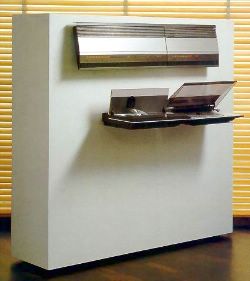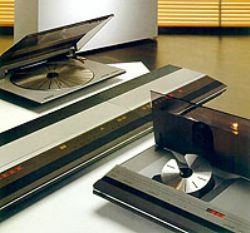BeoSystem 3300
Manufactured: 1987 - 1989
Designer: Jacob Jensen
Colours: white or metallic grey
Beosystem 3300: blending science and art
Bang & Olufsen designs are always refreshingly different - a pleasure to look at as well as to hear. Which could be why the company has earned itself over the years coveted places in the Museum of Modern Art in New York.
Beosystem 3300 was the latest addition to a collection which fascinated people from all over the world. You could hang it on the wall among your other works of art; or place it where you like - those sleek, modern shapes would always look good.
But Beosystem 3300 had a great deal more to offer than an ultra-modern appearance. With records, tapes, radio and compact discs it was a top quality music system that really knew how to perform, according to the 1988 catalogue.
Beomaster 3300
The radio-amplifier was the heart of the system, connected by Datalink to the other equipment and passing on the commands you gave via remote control, or by a light touch directly on the panel.
You could preset up to five radio stations. The amplifier had a power output of 2 x 30 watts and a power handling system which prevented overloading and distortion.
Colours: white or metallic grey
Beocord 3300
You had the benefits of the very latest technology with this tape player. Such as Bang & Olufsen's patented HX Pro recording system which enriched the sound image by giving vastly superior reproduction of the treble range.
You were certain to approve of the wealth of useful features, too. For example, if the record finished while you were recording, the tape stopped automatically and restarted automatically when you turned the record over.
When you pressed STOP after a recording, a four second pause was inserted between tracks with the automatic search system. Clever stuff - all designed to make life easier and more fun.
Colours: white or metallic grey
Beogram 3300
It is always better both for your records and for sound quality to play a record the way the master was made - in a straight line from the edge to the centre. This tangential arm record player did just that, giving a far more precise reading of the signals in the groove. The MMC4 cartridge made a vital contribution too; it was a feather-weight, with a stylus pressure of only 1,2 grams, giving outstanding sound quality but minimising wear and tear on your records.
There was more protection too - invaluable for all-night parties. The electronically controlled tangential arm was suspended so that it isolated mechanical vibrations from the cartridge. The suspension chassis was also thoroughly engineered to neutralise vibrations. So you could keep on dancing - the record player could take it!
Beogram CD3300
It's a fact that not all compact disc players are ideal for all types of music. Some of them seem to highlight certain parts of the frequency range. But you could be confident that Bang & Olufsen's CD players didn't discriminate between rock and roll and classical. They smoothed over faults in the CD very cleverly too, because not all compact discs are perfect. So it was just as well that Bang & Olufsen CD players were and still are!
BeoSystem 3300 Product Specifications
This receiver was the heart of the system, connected by Datalink to the other equipment and passing on the commands you gave via remote control, or by a light touch directly on the panel.
5 preset radio stations. The amplifier had a power output of 2 x 30 watts and a power handling system which prevented overloading and distortion.
Beomaster 3300 was part of Beosystem 3300 although it could be used as a stand-alone item.
Finish: white or metallic grey
Beocord 3300 Specifications
Types:
2941 (1987 - Jan 1990)
AUS 2945 (1987 - May 1988)
GB 2942 (1987 - Jan 1990)
USA 2943 (1987 - Jan 1990)
Compact cassette: C46-C60-C90
Recording system: HX PRO
Remote control: Terminal 3300 via Beomaster 3300
Direct operation: Sensi touch
Auto recording pauses at CD, 4 sec. pauses
Auto recording stop at CD, tape end
Search system: Pauses in music
Noise reduction system: Dolby B
Tape switch: Auto ferro/chrom
Tape head: Sendust Wow and flutter DIN: <+/- 0.15%
Fast forward and rewind: C60 110 sec
Frequency range chrome: 25 - 18,000 Hz +/- 3 dB
Signal-to-noise ratio CCIR/ARM:
Metal Dolby B: >64 dB
Chrome Dolby B: >65 dB
Ferro Dolby B: >63 dB
Power supply:
2941 220V
2942 240V
2943 120V
2945 240V
Power consumption: max. 20 W
Dimensions: W x H x D 42 x 7 x 24.5cm
Weight: 3.8 kg
Connections: AudioLink
Beogram 3300 Specifications
Types:
5931 (1987 - June 1990)
AUS 5935 (1987 - Sept 1988)
USA 5933 (1987 - June 1990)
Tonearm: Tangential Optimum Pivot Point
Motor Servo-controlled DC
Wow and flutter: < 0.06 %
Rumble DIN weighted: >80 dB
Rumble DIN unweighted: >55 dB
Speeds: 33-45 rpm
Speed deviation: <+/- 0.2 %
Power supply: 190 - 265 V
Power consumption: < 10 W
Dimensions W x H x D: 42 x 7.5 x 32.5cm
Weight 5.3 kg
Link compatibility: Data Link
Beogram CD 3300 Specifications
Types:
5141 (1987 - April 1990)
AUS 5145 (1987 - June 1988)
GB 5142 (1987 - April 1990)
USA 5143 (1987 - May 1989)
Frequency range: 3 - 20,000 Hz +/- 0.3 dB
Signal-to-noise ratio: > 96 dB / 100 dB A-weighted
Dynamic range: > 96 dB
Harmonic distortion incl. noise < 0.003% at 0 dB;
< 0.03 at -20 dB
Channel separation: > 94 dB
Channel difference: < 0.5 dB
Converter system: 16 bit, 4 x oversampling 176.4 kHz
Low pass filter: Digital + Bessel/elliptical analogue
Damping: > 20,000 Hz > 50 dB
Phase error between L and R 0 degree at 20 - 20,000 Hz
Output analogue: 2 V RMS at 0 dB
Power supply:
5141: 220V
5142: 240V
5143: 120V
5145: 240V
Power consumption: 30 W
Dimensions W x H x D: 42 x 7.5 x 31cm
Weight: 4.9 kg
Link compatibility: Data Link
Related Products
- BeoGram 3300 Record Deck
- BeoMaster 3300 Tuner/Amplifier
- BeoCord 3300 Cassette Deck
- BeoGram CD3300 Compact Disc Player
- Beovox RL 45 Passive Loudspeakers
- Beovox RL 60 Passive Loudspeakers
- Terminal 3300 Remote Controller
Created: 7th December 2006
Modified: 7th February 2007
Author Notes:






